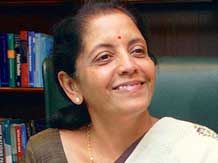 The National Democratic Alliance government on Wednesday unveiled the Foreign Trade Policy for 2015-20.
The National Democratic Alliance government on Wednesday unveiled the Foreign Trade Policy for 2015-20.
At a press conference after announcing the policy, Commerce and Industry Minister Nirmala Sitharaman and her team of officials say the policy focuses on technology and labour-intensive and environment-driven sectors.
She adds ultimately, systemic improvement, not interest subvention and incentives, will boost exports. Edited excerpts:
What are the thrust areas of the FTP for 2015-20?
It's a focused policy, one in which exports through Make in India is underlined by looking at sectors that give greater employment and have high-tech value addition.
That is because the intention is to join the global value chain and above all, the environment part, where you are looking at eco-friendly systems and producing wealth out of waste.
So, the priority areas are technology-driven, labour-intensive-driven and environment-driven.
You are also looking at traditional markets, emerging markets and diversifying into new markets.
What is the level of exports the government hopes to achieve?
In the policy, we have a tentative goal of $900 billion for merchandise and services by 2020. In 2013-14, we had $151 billion in services and $314 billion in merchandise.
We have not broken up the target into merchandise and services deliberately, as we are hoping with the changes in services and the architecture of incentives, services should fare better.
We do not want to constrain it. Let services and merchandise compete with each other.
What is the total value of the package in the FTP for five years?
The policy had to wait for six-seven months since the new government came to power.
Clearly, the policy has come out vividly and clearly on the back of support from the finance ministry.
You have spoken of a mid-term review. Does that mean we will not have annual supplements to the FTP?
We are doing it after two and a half years. We want to have consistency in the policy.
The policy announced now is for five years; we do not want periodic and unpredictable changes, which alter the overall tone of the policy.
We are committed to mid-course evaluation, after two and a half years.
What is the rate of reimbursements in the merchandise exports from the India scheme (MEIS) and the services exports from India scheme?
It is three-five per cent. For most services, it is five per cent; for four-five services, it is three per cent.
Will the scrips taken under old schemes be transferable?
New schemes will be guided by new policies and old ones by the conditions attached to the old policy.
Can scrips issued under MEIS and SEIS be reimbursed for all taxes?
Yes, all -- excise duty, customs duty and service tax.
That is why we said no conditions have been attached; these are freely transferable.
Have you scrapped any scheme?
We have consolidated and, in the process, earlier schemes have been scrapped.
Will beneficiaries of previous schemes benefit from the new ones?
By and large, not all.
The whole exercise was scientifically done.
Many times, you have products that might not require the kind of impetus that has been given; if you do a scientific analysis, these might not be the candidates.
The larger guiding principle has been from the WTO (World Trade Organization) and a multilateral trading system perspective; all of us agree systemic changes have to happen.
The route of facilitation through subsidies and interest subvention alone cannot be a sustainable one for improving trade.
What about the interest subvention scheme, which was a major boost for exporters?
The interest subvention scheme has been approved for a period of three years.
In Budget 2015-16, we have an allocation of Rs 1,625 crore (Rs 16.25 billion).
Now, we have to decide about sectors.
The selection has to be in line with the policy.
Gradually, the broader understanding will be from the point of systemic cleansing and systemic improvement, rather than interest subvention and incentives.
Special economic zones have been a thrust area. But without abolition of minimum alternate tax (MAT), will SEZs be revived?
We have clearly mentioned benefits of the MEIS and SEIS will be applicable to units in SEZs, too.
I think that will revive SEZs to a large extent. The issue of MAT on SEZs is with the finance ministry.
Is the list of e-commerce too limited for FTP benefits? Will it be expanded before two and a half years?
We might not be doing anything before two and a half years.
E-commerce is an area we have taken on board, to an extent. It is an area in which lots of things are being played out.
It's a technology-driven area, it has its own size. We will watch it.
Does the FTP have anything in terms of free trade agreements?
Now, FTAs will be looked at from the point of view of the value addition we want to become a part of the global value chain. Wherever we have FTAs, they have been covered under emerging markets.
Therefore, they are getting a higher rate of rewards. This is being done to utilise FTAs as much as we can.
Is there a proposal to join mega trade pacts such as the Trans-Pacific Partnership?
These regional and large plurilateral discussions are geo-specific, except for Vietnam, which is also being invited for the Pacific. We are going through the RCEP (Regional Comprehensive Economic Partnership), because it is geographically contiguous for us.
Image: Commerce and Industry Minister Nirmala Sitharaman











